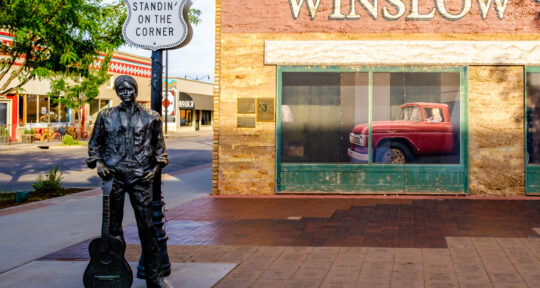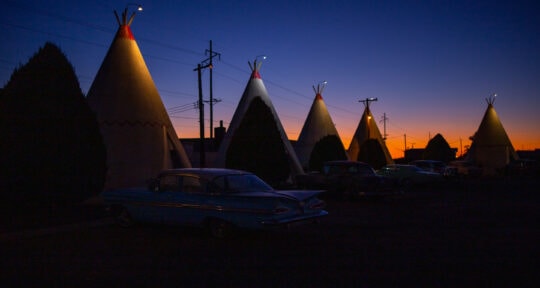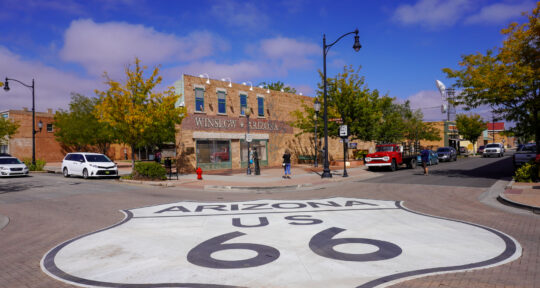Route 66 has been here before. When the Interstate Highway System was established in the 1950s, diverting traffic away from small towns along the route, business on the Mother Road slowed to a trickle. Although it was officially decommissioned in the mid-80s, the route never died completely; thanks to the continued efforts of passionate roadtrippers, small towns, and state governments, traveling Route 66—in segments or in its entirety from Chicago, Illinois, to Santa Monica, California—is still a sought-after rite of passage for people from all over the world.
Everything you need to know to plan your Route 66 road trip
When you add up the amount of modern-day and historic filling stations that sit somewhere between restored, rethought, and in ruin along the mostly two-lane road, it’s impossible to think about road trips without also factoring in the necessity (or novelty) of frequent gas stops. But unlike the economic devastation wrought by the construction of I-40 and other new highways, today’s Route 66 is in a much better place to adapt to what is arguably the most consequential technology to shake-up the travel industry in decades: Nearly 100 years after the road received its official number designation on April 30, 1926, Route 66 is going electric.
Goodbye, range anxiety
Every year it becomes easier and easier to take longer trips in electric vehicles (EVs), no matter the destination. With each new technological innovation and personal experience, range anxiety (the fear that you’ll run out of juice and find yourself stranded far from a charger) dwindles. Just as EV chargers have been increasingly popping up in national parks, hotel parking lots, and shopping malls across the U.S., multimillion-dollar projects to electrify portions of Route 66 are ensuring that the historic road will not be lost in an effort to modernize relics of the past.
Everything you need to know about roadtripping in an EV
Planning a road trip has always required stops to refuel our vehicles, our bodies, and our minds—it’s just that the task of finding an EV charger has not yet hit the tipping point from novel to normal for a majority of the population. But you can search for chargers in the same way that you’d look for a weird wax museum or breathtaking desert hike. If you really think about it, range anxiety begins to look as silly as any other type of anxiety: based in reality, but overblown and ultimately a waste of valuable time.
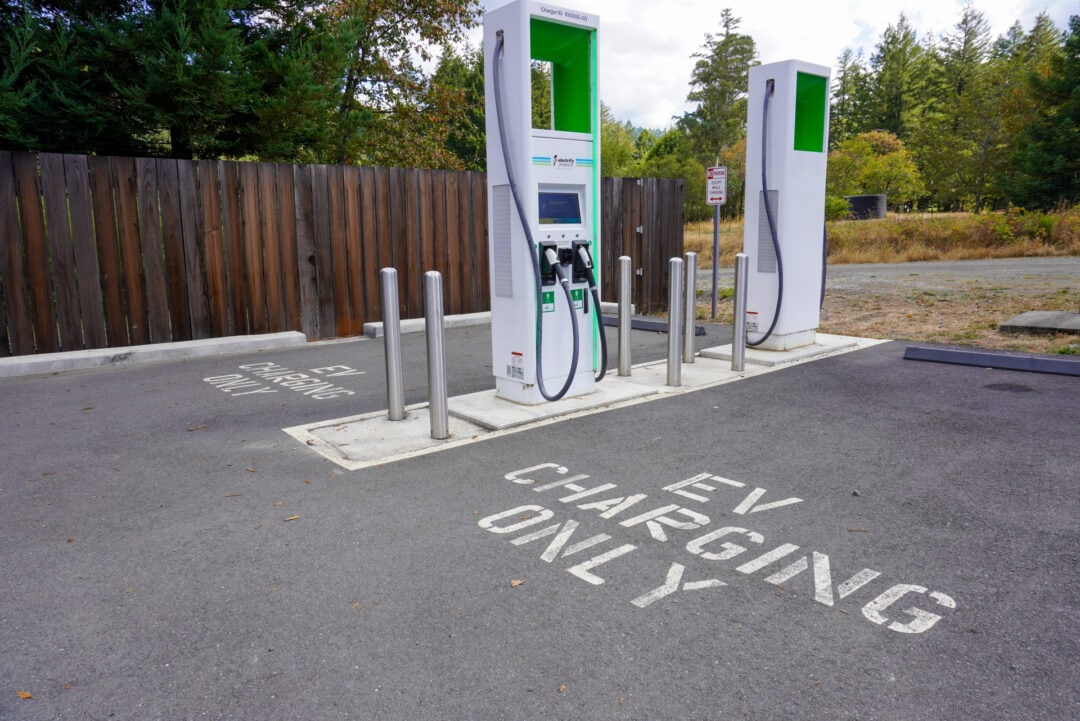
Whether you hit the historic route in search of simpler times, dazzling neon, or a really good milkshake, chances are good you’ll be charmed by something over the more than 2,000-mile route. Mike and Jessica May rediscovered their love of road trips through the eyes of their children after Pixar’s Cars grabbed the attention of the entire family. In 2018, the Mays upgraded from a Chevy Spark to a Tesla Model 3—and although Mike acknowledges that there were many EV early adopters who traveled Route 66 before his family, he says they were among the first “Route 66 roadies” to switch to a fully electric vehicle. “In our extended family of Route 66 enthusiasts we were, and still are, fairly unique,” he says.
Lightning McQueen and Tow Mater hit the road again in a new animated series
Mike says their EV experience and enthusiasm led to starting the blog Electric Route 66 “to use our perspective to inform our friends and others about EV roadtripping.” For frequent travelers, driving an EV means less money spent on gas and repairs, and, as Mike puts it, “more money spent making memories and supporting the mom-and-pop businesses on Route 66 that need visitors to stay viable.”
The Mays may be early adopters, but they’re not alone: The Route 66 Electric Vehicle Association (Jessica is the current president), founded in 2020 as a chapter of the nationwide Electric Vehicle Association, holds monthly Zoom meetings from January to October, to discuss EV roadtripping and developments along Route 66. For its Earth Day issue in March 2020, National Geographic published a travelogue: “We took the Great American Road Trip—in electric cars.” At the end of thousands of miles from Santa Monica to Washington, D.C.—an itinerary that hit portions of Route 66, and then some—the writer concludes: “Americans adapt quickly, once convinced that change is necessary, even useful. It could happen again.” In April of this year, Ford sponsored Alan Winninger to drive a Mustang Mach-E Ford (complete with a “fake exhaust”) along Route 66.
Keeping the Mother Road alive
Although barriers still remain—including small businesses on tight budgets and historic spaces ill-equipped for heavy electricity usage—some notable Route 66 icons have installed chargers recently, including Tucumcari’s Blue Swallow Motel; La Posada Hotel in Winslow, Arizona; and the Goffs Schoolhouse in California. Tesla Superchargers can also be found in Shamrock, Texas; Kingman, Arizona; and Pontiac, Illinois. Mike says even slower chargers “can encourage a traveler to stop somewhere they might not have known about, to eat lunch, learn about the area, buy souvenirs, etc., and keep these classic stops of Route 66 alive for the future.”
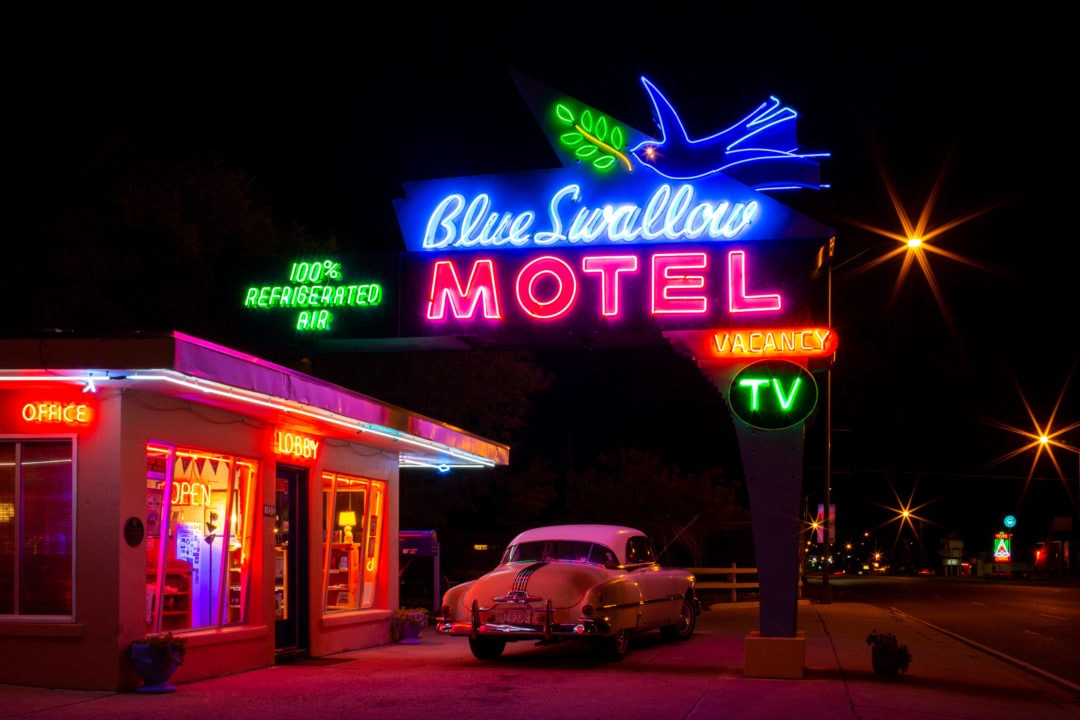
Most of the current efforts for EV infrastructure along the Mother Road come from the top: “Many state governments along the Route 66 corridor have recognized the potential economic impacts of rolling out EV infrastructure to support travelers and their tourist spending,” Mike says. The state of Arizona recently released its EV infrastructure plan, including a site planned for Seligman, home to the Snow Cap Drive-In and Angel and Vilma Delgadillo’s Original Route 66 Gift Shop.
How one man’s dedication is keeping the Mother Road alive
“The main challenge with EV roadtripping right now is planning your stops,” Mike says. “In the same way that an RV driver or someone who is towing should be aware of their fuel usage and plan ahead for their next gas stop, especially in the western U.S. where towns are more sparse, an EV driver should plan their next charging stop, and make sure to charge enough to get there.”
Mike, who is also currently on the board of trustees of the California Historic Route 66 Association, says that driving Route 66 in its entirety is more than possible in an EV, thanks in part to Tesla Superchargers, which have been available across the route since 2016, and fast-charging networks such as Electrify America and ChargePoint. The Mays haven’t quite made it all the way yet, but not because of lack of infrastructure or desire: “We have traveled nearly all of the Route 66 corridor in our Tesla, excepting about 70 miles at the east end near Chicago, which we simply haven’t had time to get to yet,” Mike says. “It’s a long drive from Las Vegas, no matter what you’re driving.”
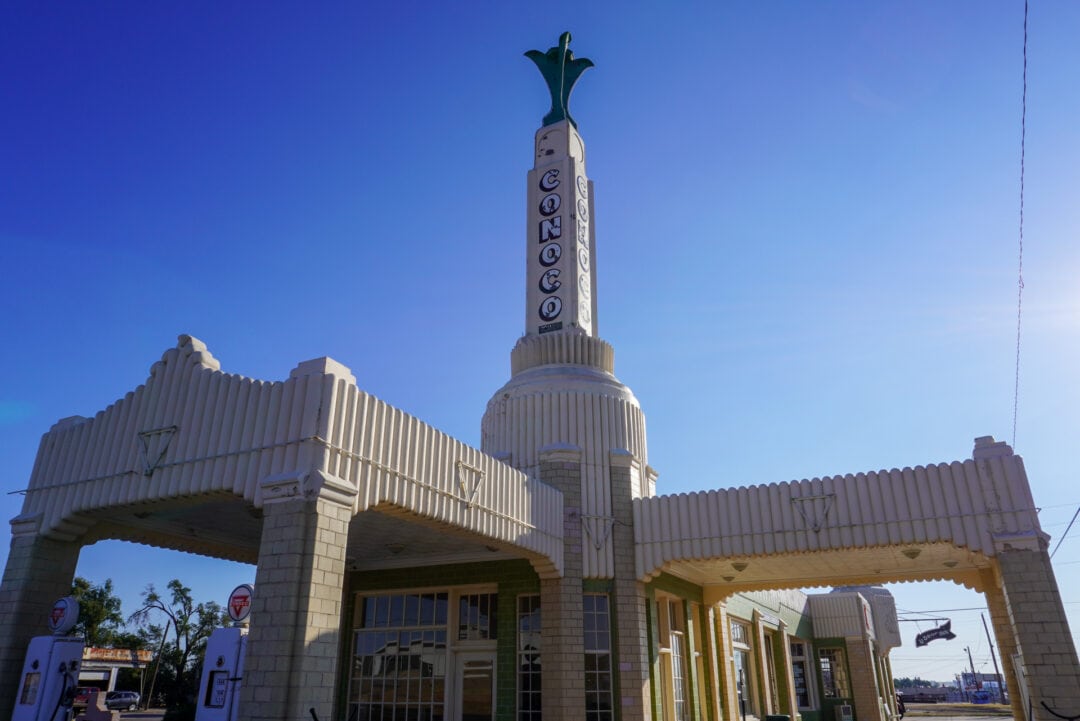
No turning back
EVs may still seem new, but the idea is nearly as old as electricity itself. Tesla Inc., perhaps the best-known modern manufacturer of all-electric cars, was founded in 2003 and took its name from the famously-eccentric inventor who died alone in a New York hotel room after he was hit by a cab in 1945 on his way to feed pigeons. Today, EVs are historic enough to have their own museum: In 2014, the International Electric Vehicle Museum opened in Kingman—a first for the Mother Road, and possibly the world.
Like with any new technology, adaptation of EVs is still coming in dribs and drabs, but it’s clear that there is no turning back: “The transition to interstates was a significant change in transportation that left many small towns behind,” Mike says. “The next big transportation change is the switch to EVs, and we want all of our great Route 66 friends to come with us.”

